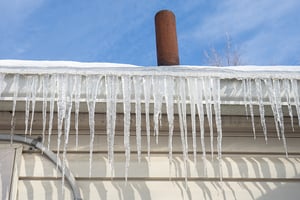Protecting Your Home from Ice Dams

Ice dams can damage your roof and result in water damage to your home. Don’t let this cold-weather risk take you by surprise. Learn how to protect your home from ice dams.
What Are Ice Dams?
Ice dams can form on the edges of a roof when snow melts during the day and freezes again at night. According to the National Weather Service, after several days of melting and refreezing, the ice can get under roof shingles. Ice dams also trap water on the roof by blocking the water from draining properly. This can allow water to enter the attic, where it can lead to water damage and mold and mildew growth.
How to Prevent Ice Dams
When it comes to ice dams, prevention is the best strategy.
Keep your gutters and downspouts clear. Leaves and other plant matter can clog your gutters and prevent water from draining properly. Ahead of the first snowstorms, make sure you’ve cleared out autumn plant debris, and keep your gutters clear throughout winter.
Have your attic checked for proper ventilation and insulation. Good insultation and venting can prevent the melting and refreezing cycles that lead to ice dams. The National Weather Service says that most experts recommend an R-value of at least 30 for attic insulation, and an R-value of at least 38 is ideal in northern climates.
The National Weather Service also suggests removing heavy snow loads from your roof. This can be done with a roof rake, but the process must be done carefully to prevent injury to yourself and property damage to the roof. Consider hiring a professional team to remove snow.
Some people use heat cables to prevent ice dams. If you are considering this option for your home, talk to an expert to understand the pros and cons.
How to Spot Ice Dams
During cold weather, it’s smart to monitor your house for ice dams. You should pay attention to both the interior and exterior of your home.
Check your home for signs of leaks and mold. If you see signs of water damage on the ceiling or walls, you may have an ice dam.
Look for icicles. These ice formations are a common sign that you may have ice dams.
Keep an eye out for other signs of ice. For example, if your gutters appear to be blocked with ice, or if water is dripping down your walls where it shouldn’t be, you might have an ice dam.
How to Remove Ice Dams
Ice dams can cause serious damage to your roof, as well as severe water damage to the interior of your house. If you detect an ice dam, prompt action is important to prevent additional damage.
However, just like removing snow from your roof, removing ice dams can be dangerous. You may also inadvertently cause additional damage to your roof. A professional will know how to handle the process safely.
Once the immediate problem has been addressed, it’s time to think about long-term solutions. If ice dams have formed once, they will likely form again. Consider investing in renovations, including better insulation and venting, to prevent future problems.
Insurance Coverage for Ice Dam Damage
Homeowners insurance may provide coverage for damage caused by ice dams. To learn more about coverage for ice dams, talk to an insurance agent at BNC.






